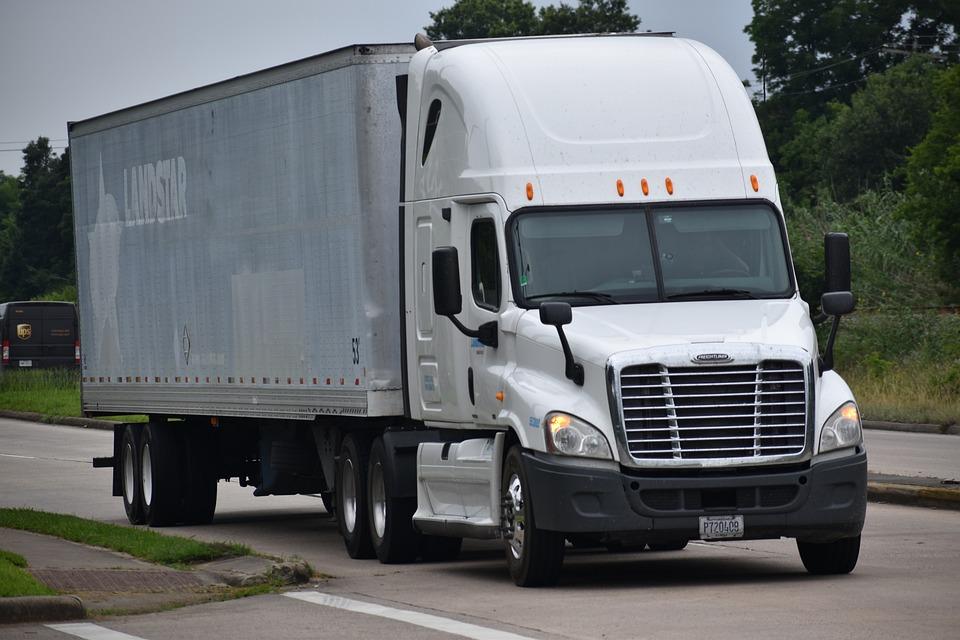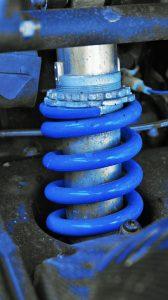The shock absorber is one of the most vital components in any vehicle’s suspension system. When travelling on rocky roads or encountering sudden bumps in the road’s surface, a shock absorber minimises any rough movement in the vehicle, allowing you and your trailer load to have a smooth journey.

The Function of Shock Absorbers
Shock absorbers (aka ‘dampers’) are pump-like safety mechanisms that are a part of the vehicle’s suspension system. They ensure your vehicle’s tyres are in contact with the road surface at all times, whilst easing the impact of sudden bumps or changes in the road.
The shock absorber has multiple components that allow it to extend and compress along with the movement of the tyres. These components consist of:
- A ‘pressure cylinder’ which is a name for the body of the absorber, where the absorption process takes place.
- The cylindrical body has separate oil chambers inside where the oil moves around during compression and rebound strokes.
- It also has ‘base valves’ and ‘piston valves’ where the oil flows through during compression and rebound strokes. Compression strokes happen when the tyres move the piston up and it compresses the oil inside. Rebound strokes are the opposite, when the piston is back to its full length and is usually when the tyre moves downwards.
- Lastly, there’s a piston which moves in and out of the pressure cylinder as it follows the tyre movement and works hard to keep the tyres on the ground. The faster or smoother a piston moves, the more effective it is to movement.
Categories of Shock Absorbers
Trucks need a strong and reliable shock absorber, especially as they carry heavy weights and sometimes fragile items. There are three main types of shock absorbers which also have subcategories.
The first main type is a regular ‘hydraulic telescopic’ shock absorber, which is the most common type found in vehicles. The subcategories that fit under this type are:
Mono-tube
A mono-tube is a fairly simple absorber device. It has a piston which has compression and rebound valves at the end of it, and no base valves. A separator sits near the bottom of the cylinder which separates the oil that is held at the top and the nitrogen gas that is held at the bottom. At compression, the compression valves at the end of the piston allow oil to flow through as it moves downwards. At rebound, the gases push against the separator which helps lift the piston back to its original position. These are good as it creates zero oil foaming (when bubbles are created inside the chamber) and has consistent performance in rocky environments.
Twin-tube
Twin-tubes have both piston and base valves which work together to let oil pass through them during compression and rebound strokes. The base valve allows the oil to flow through the secondary tubes when the chamber hits full capacity during compression. A disadvantage of this, though, is that oil foaming can happen easily, thus making the oil movement that happens inside the chamber inconsistent.
Gas-filled
Gas-filled (AKA gas-charged) absorbers are a better alternative to the twin-tube type. This is because it has nitrogen gas inside the secondary tubes, alongside the oil, which pushes the oil back when there is a rebound stroke. With the gas inside, there is no room for bubbles to form, so oil foaming doesn’t occur. When it is compressed, it is stiffer due to the oil and nitrogen having to move around the piston. The piston’s rebound strokes are assisted by the gas pushing the oil up the chamber. This is different to a mono-tube as it has base valves and a second set of tubes, just like a twin-tube absorber.
The second type of shock absorber is the ‘position-sensitive damper’ (PSD). They have different areas with two levels – comfort zone and control zone. The comfort zone is low resistance, so movement is easier, whilst the control zone is high resistance, so movement is harder or firmer. These are in two subcategories:
Groove type
In a groove type, the control zones have no grooves so there is less space for the oil to move, whilst the comfort zone features grooves which give the oil more space. These can be tuned by changing the number or position of the grooves as appropriate.
By-pass type
In a by-pass type, the pressure cylinder (the body) has holes or gaps inside which allow the oil to pass through them from one position in the cylinder to the other. For example, a by-pass at the top of the cylinder will move the oil to the by-pass at the bottom. At rebound, it is more resistant as the piston has to wait for the oil to move back from where it was by-passed in order to move back up to its full length. These can also be tuned by changing the number or position of by-passes – either adding or subtracting the number of control or comfort zones. This can be useful if you need smoother movement of the piston so more comfort zones would be a suitable option.
The last main type is an acceleration-sensitive damper. It has a ‘spring seat’ valve which is attached to the piston and is sensitive to acceleration of the piston. This acts when there is a sudden bump in the road at high speed, by compressing quick to absorb the shock. The spring is compressed as the oil moves up the piston’s valves quickly and, as there is only so much space, the spring constricts to allow movement. However, if there is a small bump or gradual change in the road surface, the spring valve moves along with the piston, with no compression. An advantage of this absorber type is that it automatically adjusts with the tyre’s movements so it can absorb sudden shocks easier.

In summary, shock absorbers are a hidden yet important safety feature within the suspension system which should be maintained. To check your absorbers are working at full capability, there should be very minimal shaking of the vehicle, and sudden bumps shouldn’t cause any lifting of the tyres. HGV trucks need a sturdy shock absorber to keep up with the movement of large tyres, as well as to keep the fragile goods safe in the trailer.
Be assured that your goods won’t be rattled by purchasing a shock absorber from our site. We carry a wide range of branded absorbers for replacement (front and rear), including DAF, IVECO, MAN, etc. We supply all for a great price!








0 Comments